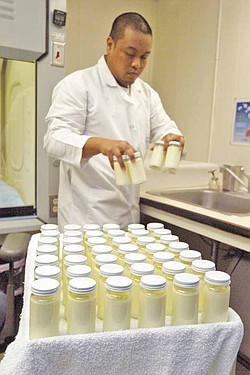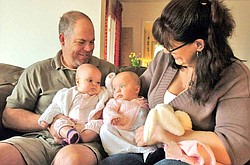Breast milk banks
MCT
Gerald Astrero, a lab technician at the Mother's Milk Bank, prepares donated breast milk for distribution in San Jose, California, March 22, 2011. The 37-year- old non-profit distributes 420,000 ounces of breast milk a year.
MCT
Mike Rose, left, holds daughter Sophia as Stephanie Lovell-Rose, right, holds Sophia's twin sister Allison at home in El Cerrito, California, March 24, 2011. Allison and Sophia, who were born premature, receive supplemental milk from the Mother's Milk Bank.
Sharing of mothers’ milk grows in popularity, but experts warn about risks
McClatchy Newspapers
WALNUT CREEK, Calif.
After the birth of her daughter five years ago, Cynthia Li, of Berkeley, Calif., was diagnosed with a severe thyroid condition and was unable to breast feed.
Knowing the benefits of human milk, Li didn’t want to use formula and lamented her situation to a friend. The friend offered to send out a mass email on Li’s behalf asking like-minded moms to donate their extra breast milk.
Within one day, she received 20 calls. She accepted a water cooler full of breast milk from a woman whose daughter was the same age as Li’s daughter, Rosa.
It may sound unusual, but sharing breast milk is a growing trend, from online trafficking to grass-roots organizations such as Eats on Feets to informal arrangements such as Li’s. It also has a long history, from wet nurses — lactating women for hire — to co-nursing among relatives, particularly in ethnic families.
However, following recent warnings from the Food and Drug Administration and the Surgeon General about the potential risks associated with donor breast milk, experts say that using an accredited milk bank — where donors are screened and expressed milk is processed in a lab — is the best way to provide human milk to a baby who cannot get it from mom.
The Mothers’ Milk Bank of San Jose, one of 10 banks accredited by the Human Milk Banking Association of North America, distributed 420,000 ounces of breast milk last year, a 25 percent increase from the previous year, Executive Director Pauline Sakamoto said. The nonprofit bank is state licensed and the first to receive endorsement from the Food and Drug Administration.
However, there is not an endless supply of breast milk. Half of the bank’s milk goes to hospitalized preemies, whose weak intestinal tracts have trouble digesting formula and need the natural growth hormones in human milk; the other half goes to babies younger than 1 year of age with a prescription from a pediatrician. Typically, they are allergic to formula or mom is unable to nurse because of an illness or other reason.
With the $3-an-ounce price tag, it is not an option for many families.
Experts think the antibodies and white blood cells in human milk are beneficial to growing babies.
Breast-fed babies also are at a reduced risk for infections, digestive issues and chronic illnesses. For those reasons, some women are resorting to eBay or Craigslist, where recently, a “healthy, 22-year-old mother” listed her breast milk for $2 an ounce.
Other women turn to their communities, relying on good instincts to make informed decisions.
The woman that Li received her milk from was in good health and offered her medical records, but Li said she didn’t need to see them.
Since November, Wilma Ruth Torres, of Fremont, Calif., has donated more than 1,000 ounces of her breast milk to Mothers’ Milk Bank. Pumping is time consuming, she said, but well worth it knowing the milk is going to help sick babies.
In her work as a midwife, Shell Walker has helped facilitate casual milk sharing for more than 20 years. Now she does it through her Facebook-based nonprofit, Eats on Feets. The group is free and recommends that moms obtain the same donor screenings as the milk banks.
The organization also encourages mothers to make informed decisions about safe handling and home pasteurization.
“We’re just a place for moms to post a need or abundance in their area,” said Walker, who manages Eats on Feets Facebook pages in 35 cities.
Still, health professionals and other nursing advocates, including La Leche League International, caution against casual milk sharing because of potential risks to the baby, such as infection, bottle contamination, and the reality that some viruses and diseases are asymptomatic, said Diana Mahar, a pediatrician at Kaiser Permanente Pinole and a breast-feeding spokeswoman for the American Academy of Pediatrics.
“It’s not a decision you should take lightly,” she said.
The concept, however, is ancient. According to Mahar, before the availability of artificial milk, if a mother was not able to nurse her infant, having a family member or other woman to nurse the baby was lifesaving.
“There were also many places around the world where wealthy women would use wet nurses because it was a sign of wealth and class and, in some cases, because it would allow them to get pregnant again sooner,” she said.
Perhaps in the same way, milk from a milk bank may reduce some people’s trepidation.
Donors are put through rigorous screenings. They must be nonsmokers in good health whose blood tests are negative for herpes, HIV and syphilis, Sakamoto said. Their milk arrives to the bank frozen and is thawed, heat-pasteurized to eliminate bacteria, lab tested, frozen and stored before shipment.
That process put Stephanie Lovell-Rose, of El Cerrito, Calif., at ease when it came time to feed her premature twins. Allison and Sophia were born eight weeks early and weighed 3 and 4 pounds, respectively.
They needed to be tube-fed for a month. Lovell-Rose’s insurance covered the hospital-grade donor milk; once she brought the babies home, however, the $72 a day was her responsibility.
“It is so worth it; they are really thriving,” Lovell-Rose said of her daughters, who are now five months old and weigh about 13 pounds each.
“They’re a long way from the little preemies we brought home.”
Copyright 2011 Associated Press. All rights reserved. This material may not be published, broadcast, rewritten, or redistributed.
 43
43


